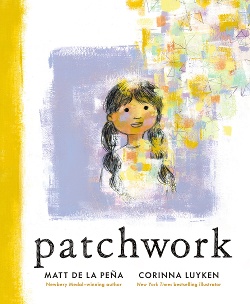Corinna Luyken's art in Patchwork guides readers to the intended interpretation of the picture book's text, filling in its gaps and allowing the reader to gain purchase on possible meanings, argues Megan Dowd Lambert.
[Many Calling Caldecott posts this season will begin with the Horn Book Magazine review of the featured book, followed by the post's author's critique.]
 Patchwork
Patchwork
by Matt de la Peña; illus. by Corinna Luyken
Primary Putnam 48 pp. g
8/22 978-1-9848-1396-1 $18.99
Spanish ed. 978-0-593-53234-8 $18.99
A rhythmic text speaks to an unnamed child in the second person, describing what “we see” and how that trait or characteristic may inform a young person’s future identity (for better or worse) and how they might see themself. In the first vignette, readers meet a child identified with “blue” at a gender-reveal party. With the page-turn, we learn they are “blue dressed in blue,” but their paintbrush at times “hovers above the pink.” As the character matures, though, “the color you will come to love most / is brown” — presumably the brown of their own skin. De la Peña’s text does not specify whether it’s directed at one figure or many, but Luyken illustrates each vignette with a different child, all part of a multiracial cast: a dance-loving tot grows up to find rhythm in computer code; a young athlete (“You are basketball-baseball-fútbol-any-kind-of-ball”) becomes a bilingual poet; a class clown becomes a compassionate teacher. Luyken’s backgrounds feature brushy squares, a visual motif that plays on the title. The “we” that observes and speaks to each character becomes broadly expansive at the end, enfolding narrator, characters, and readers: “We are beautiful.” Gentle and affirming. VICKY SMITH
From the November/December 2022 issue of The Horn Book Magazine.
I knew just how I wanted to approach this piece when I sat down to write it, all beginning with the title. The single word, patchwork, invites metaphorical interpretation, and I immediately appreciated how Corinna Luyken supports this effort by eschewing a literal depiction of a patchwork quilt on the jacket art to offer instead an impressionistic illustration of a child gazing out at the reader from within a lavender square. As I looked at the portrait, I asked myself, Is it a quilt square? Are we to understand that this child is just one quilt square in the large patchwork of humanity?
I looked closer. There is also a rough pastel patchwork of color on the child’s chest. It covers the place where her heart beats and then seems to rise up and radiate into the space above her, beyond the lavender (quilt) square and into and out of the upper-right corner of the jacket art. Are we to understand that she isn’t just a square in the large patchwork of humanity, but is, all by herself, a patchwork, too?
Text on the back of the jacket validates this latter interpretation: “You are more than a single note / played again and again. You are a symphony.” When I first read these lines and looked back at the picture of the girl in the lavender square with the patchwork over her heart, words from Walt Whitman’s Song of Myself came to mind: “Do I contradict myself? / Very well then I contradict myself, / (I am large, I contain multitudes.)” Aha! I thought. This child depicted on the jacket contains multitudes — she is more than a single note, and the song of herself is a symphony. Feeling quite satisfied with this intertextual interpretation, I set out to explore how Luyken carries it though the book.
As you may already know, author Matt de la Peña actually was thinking of those Whitman lines as he wrote this text. I discovered this fact only after making the connection myself, when I read the following on his blog:
I think Walt Whitman had it right when he famously declared: “I contain multitudes.” We ALL contain multitudes. That’s what makes each of our twisting, turning journeys so fascinating. And there’s a bigger picture, too. All of our individual lives fit into the intricate patchwork of humanity, where no single path or identity is more beautiful or worthy than another. https://mattdelapena.com/patchwork/
While satisfying to have my interpretation of the text validated by the author himself, I also thought, Well, dang it. What am I supposed to write about now? And then I saw the obvious answer: this is precisely how distinguished picture book art can work. It guides readers to the intended interpretation of a text, filling in its gaps and allowing the reader to gain purchase on possible meanings. How absolutely wonderful that Luyken’s jacket art led me right to de la Peña’s intention.
And her achievement carries on into and throughout the book, too. Under the jacket are six pastel blocks of color, framing six different children (including the one from the jacket). In the book proper, several spreads are devoted to each child, following them from singular labels that society assigns them into a fuller appreciation for the complex, wonderful, and even contradictory individuals they are. Luyken takes care to depict them as individually distinct people with varied skin tones, hair textures and lengths, and facial features.
But they are all clearly children, and here’s where I think the book as a whole excels in its “recognition of a child audience.” Whitman’s Song of Myself is written in the first person, boldly defying anyone who would box him into a tidy definition of simplistic selfhood. That stance requires maturity and confidence, and while such attributes aren’t utterly foreign to childhood, de la Peña’s text wisely employs direct address to speak to children in the second person, rather than attempting to speak as them:
“You were blue before you were even born” (leading off a section that seems to explore a child who resists traditional masculine gender norms);
“You go everywhere with a ball in your hands” (opening a section about a child who may be de la Peña’s child self, athletic and poetic);
“You are the kid perpetually in time-out” (inviting readers to meet a child whose exuberance makes them first a square peg trying to fit in a round hole at school, and then a favorite teacher as a grownup).
The repeated use of the second person implicates child readers as “you,” while Luyken’s sensitive depictions of diverse children in a range of situations hold space for readers to imagine themselves into or to identify with these scenarios. The result is a text that offers reassurance and guidance to readers who perhaps aren’t yet equipped to sing the symphonic songs of themselves, though they sense the music within themselves.
ALREADY A SUBSCRIBER? LOG IN
We are currently offering this content for free. Sign up now to activate your personal profile, where you can save articles for future viewing.








Add Comment :-
Be the first reader to comment.
Comment Policy:
Comment should not be empty !!!